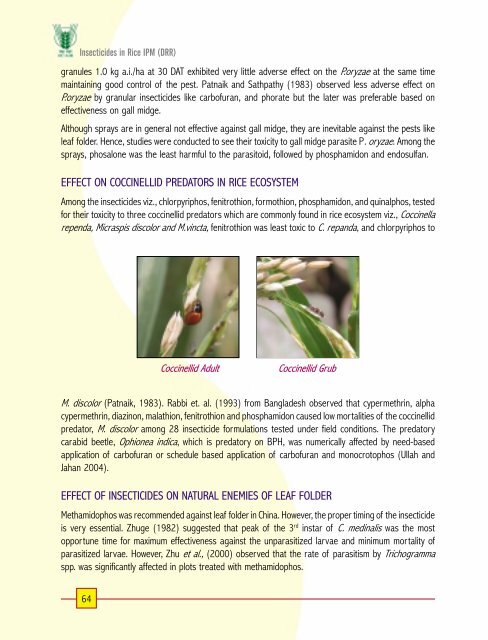priciples of insecticide use in rice ipm
priciples of insecticide use in rice ipm
priciples of insecticide use in rice ipm
Create successful ePaper yourself
Turn your PDF publications into a flip-book with our unique Google optimized e-Paper software.
Insecticides <strong>in</strong> Rice IPM (DRR)<br />
granules 1.0 kg a.i./ha at 30 DAT exhibited very little adverse effect on the P.oryzae at the same time<br />
ma<strong>in</strong>ta<strong>in</strong><strong>in</strong>g good control <strong>of</strong> the pest. Patnaik and Sathpathy (1983) observed less adverse effect on<br />
P.oryzae by granular <strong><strong>in</strong>secticide</strong>s like carb<strong>of</strong>uran, and phorate but the later was preferable based on<br />
effectiveness on gall midge.<br />
Although sprays are <strong>in</strong> general not effective aga<strong>in</strong>st gall midge, they are <strong>in</strong>evitable aga<strong>in</strong>st the pests like<br />
leaf folder. Hence, studies were conducted to see their toxicity to gall midge parasite P. oryzae. Among the<br />
sprays, phosalone was the least harmful to the parasitoid, followed by phosphamidon and endosulfan.<br />
EFFECT ON COCCINELLID PREDATORS IN RICE ECOSYSTEM<br />
Among the <strong><strong>in</strong>secticide</strong>s viz., chlorpyriphos, fenitrothion, formothion, phosphamidon, and qu<strong>in</strong>alphos, tested<br />
for their toxicity to three cocc<strong>in</strong>ellid predators which are commonly found <strong>in</strong> <strong>rice</strong> ecosystem viz., Cocc<strong>in</strong>ella<br />
rependa, Micraspis discolor and M.v<strong>in</strong>cta, fenitrothion was least toxic to C. repanda, and chlorpyriphos to<br />
M. discolor (Patnaik, 1983). Rabbi et. al. (1993) from Bangladesh observed that cypermethr<strong>in</strong>, alpha<br />
cypermethr<strong>in</strong>, diaz<strong>in</strong>on, malathion, fenitrothion and phosphamidon ca<strong>use</strong>d low mortalities <strong>of</strong> the cocc<strong>in</strong>ellid<br />
predator, M. discolor among 28 <strong><strong>in</strong>secticide</strong> formulations tested under field conditions. The predatory<br />
carabid beetle, Ophionea <strong>in</strong>dica, which is predatory on BPH, was numerically affected by need-based<br />
application <strong>of</strong> carb<strong>of</strong>uran or schedule based application <strong>of</strong> carb<strong>of</strong>uran and monocrotophos (Ullah and<br />
Jahan 2004).<br />
EFFECT OF INSECTICIDES ON NATURAL ENEMIES OF LEAF FOLDER<br />
Methamidophos was recommended aga<strong>in</strong>st leaf folder <strong>in</strong> Ch<strong>in</strong>a. However, the proper tim<strong>in</strong>g <strong>of</strong> the <strong><strong>in</strong>secticide</strong><br />
is very essential. Zhuge (1982) suggested that peak <strong>of</strong> the 3 rd <strong>in</strong>star <strong>of</strong> C. med<strong>in</strong>alis was the most<br />
opportune time for maximum effectiveness aga<strong>in</strong>st the unparasitized larvae and m<strong>in</strong>imum mortality <strong>of</strong><br />
parasitized larvae. However, Zhu et al., (2000) observed that the rate <strong>of</strong> parasitism by Trichogramma<br />
spp. was significantly affected <strong>in</strong> plots treated with methamidophos.<br />
64<br />
Cocc<strong>in</strong>ellid Adult Cocc<strong>in</strong>ellid Grub











